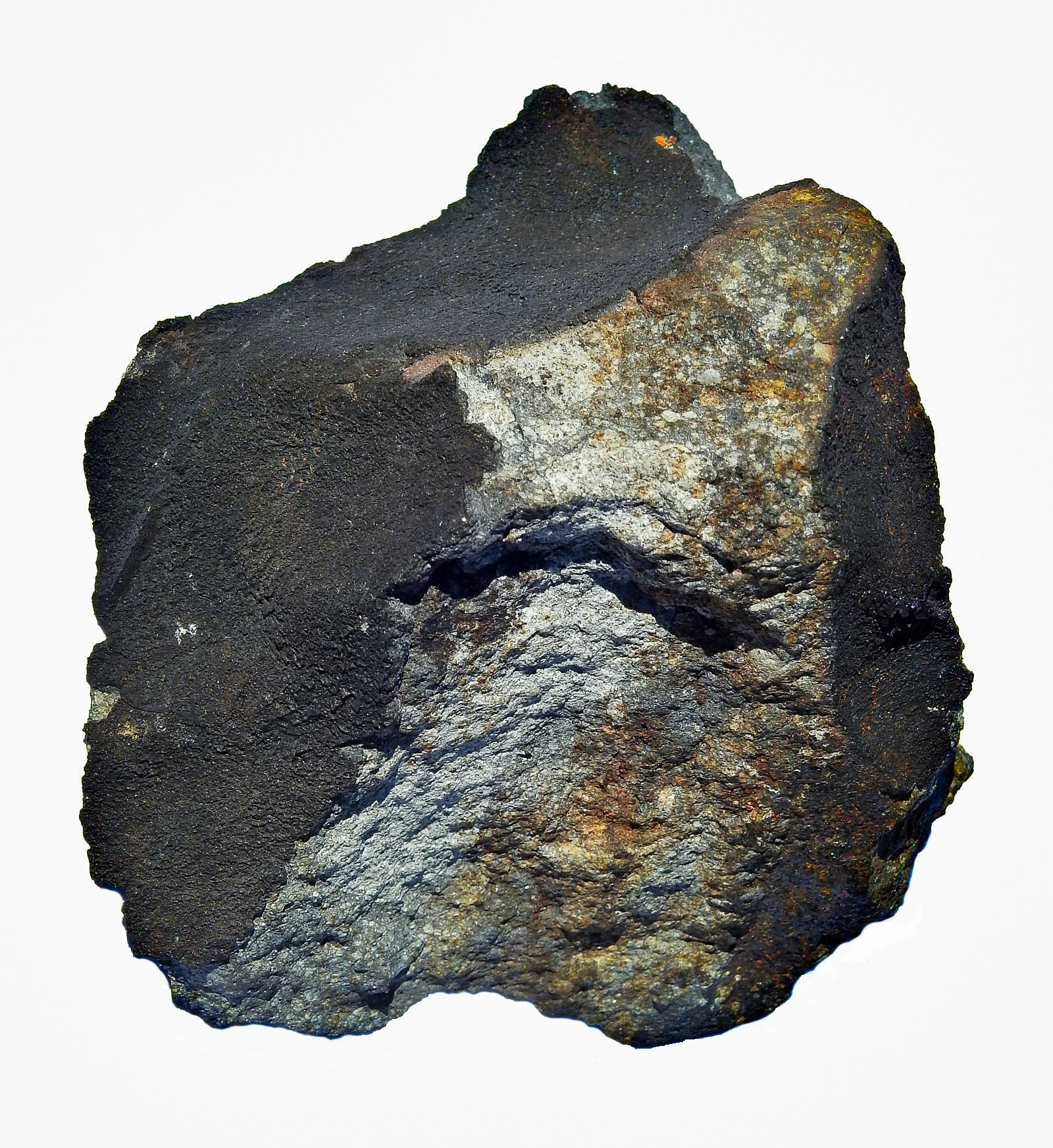| |
Click here to view this video directly on YouTube
|
|
Roll Overs:
#1
#2
#3
#4
|

|
260 grams. 78 x 70 x 41 mm. H3-6
TKW 175 kg. Observed fall, August 4 or 5, 1998, in the western Sahara.
Steve writes:
Zag was a very large fall that, at 175 kg TKW, affords collectors easy access to a scientifically intriguing meteorite. This particular Zag half-stone weighs 260.4 grams and measures 78 x 70 x 41 mm (3” x 2.75” x 1.6”). Besides displaying fresh but broken fusion crust on the uncut side, its cut surface demonstrates a number of the different lithologies seen in the Zag H3-6 breccia, including the one that contains water-bearing halite crystals. This piece also exhibits a presumed nickel-iron vein running diagonally across its cut face (as seen in the upper right portion of its respective picture). A corresponding bulge in the fusion crust opposite that vein suggested it might run all of the way through, so a 3D x-ray video scan was performed that verified the presence of a broken sheet of metal (as seen in the included video excerpt from that scan).
While fluid inclusions had previously been found in several chondrite and achondrite meteorites 1, Zag is the second of only two – Monahans (1998) being the first – to exhibit cosmic-ray altered purple and blue halite crystals with water trapped inside. This particular piece was purchased from Edwin Thompson, who first discovered the halite in Zag after cutting pieces of the meteorite using alcohol to cool the blade (water was avoided in an attempt to discourage oxidation of the nickel-iron). Purple crystals were observed immediately after cutting, but over time they attracted moisture from the air and eventually dissolved, leaving oxidized areas like that seen running up and down in the photo of the meteorite’s cut face (a blow-up of a part of that area is also included). While some of these crystals dissolved rather quickly, others lasted for months and allowed their subsequent study by several researchers, including NASA’s Dr. Michael Zolensky (who studied Monahans as well) 2. As a consequence of such work, Zag has proven to be scientifically important, contributing to our understanding of the role that water played in our early solar system and adding to the debate regarding how early life began 3.
Regarding the source of water on Earth, cometary water is chemically different from its terrestrial counterpart, complicating the theory that ours was deposited here by comet bombardment 4. Conversely the discovery of water-bearing halite crystals in the Zag and Monahans meteorites offers the possibility that asteroids were another source of Earth’s early water. Zag and Monahans are otherwise typical H-type chondrites, a class of meteorites thought to have originated on the 120 mile wide S(IV)-type main belt asteroid 6 Hebe (6 Hebe’s orbit is resonant with Earth’s, making it fairly easy to send fragments on Earth-crossing trajectories). Water on asteroids is not unique – scientists have observed water ice on asteroid 24 Themis and water vapor erupting into space from Ceres – and while water has not been directly observed on 6 Hebe, observations in the 1.9-3.6 micron region do show evidence of hydrated minerals that suggest at least a prior presence of surface water. As a consequence, some researchers expect to find halite crystals in other H-type chondrites as well.
Although proven definitively extra-terrestrial by the presence of iodine-129 and xenon-129 5, Zag’s sodium chloride crystals also contain potassium chloride, which is common in terrestrial salt deposits left after sea water evaporates. This observation is consistent with the theory that radioactive material within Zag’s original parent body melted and subsequently evaporated its salt-water ice, leaving behind the halite. A different theory suggests that water released from comet or water-bearing asteroid impacts percolated through the piles of impact debris, forming salty deposits. Either way, analyses indicate that Zag’s water-bearing halite crystals appeared within 2 million years of our solar system’s birth, pushing back by almost 100 million years the time scientists thought water originally appeared 6 and making Zag’s inclusions even older than chondrules. (Prior to Zag, the chondrules in meteorites - thought to have formed during the first 5 million years after the birth of our sun 7 – were considered to be some of the oldest material we had.) The actual Zag breccia likely resulted from a collision on its parent body some 300 million years later.
Thanks for looking at my pics and reading these notes. My hope is that you found them enjoyable and that the additional detail was interesting and maybe even a bit educational.
References:
1 www.geochem.geos.vt.edu/fluids/pdf/roedder/231_HI.pdf
2 www.psrd.hawaii.edu/Nov99/PurpleSalt.html
3 www.indiana.edu/~geol105b/images/gaia_chapter_10/Intersteller_organics.htm
4 www.astrobio.net/topic/solar-system/meteoritescomets-and-asteroids/meteorites-most-likely-source-of-earths-water/
5 stardust1.jpl.nasa.gov/news/news82.html
6 www.spaceref.com/news/viewpr.html?pid=1989
7 science.sciencemag.org/content/273/5276/757
|
Click to view larger photos
#1
#2
#3
#4
|
Found at the arrow (green or red) on the map below
|
|
| |
John Divelbiss
10/20/2016 1:47:37 PM |
awesome cut Zag breccia and thanks for the information. Zag has always been an underrated meteorite to me. Glad to see such a beautiful Zag specimen. |
Bernd Pauli
10/20/2016 7:08:23 AM |
The additional detail was both interesting and educational! Thanks for sharing pics + info with us! |
Graham
10/20/2016 5:45:59 AM |
Many thanks for sharing your great sample and all the info Steve. |
| |
|